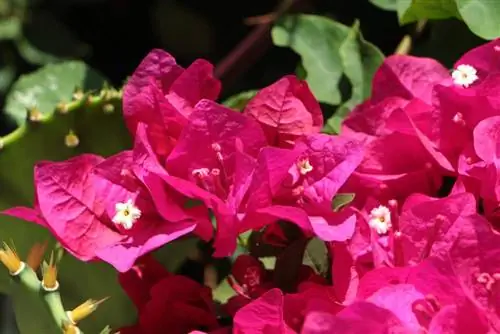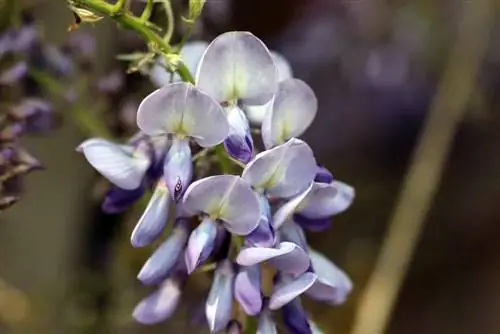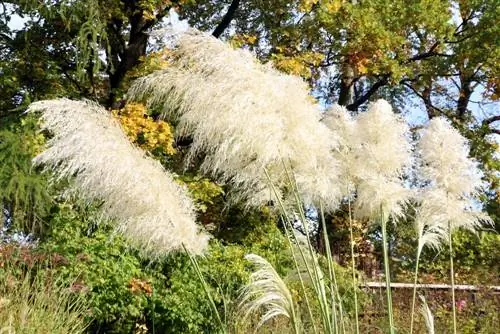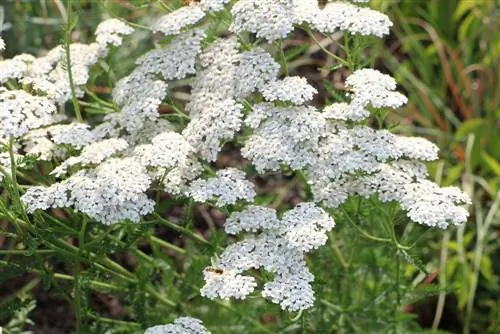- Author admin [email protected].
- Public 2023-12-17 03:39.
- Last modified 2025-06-01 06:48.
In southern countries, especially around the Mediterranean, bougainvillea conquers entire walls of houses and blooms lushly and colorfully between April and October. This flower magic is also what gives the miracle flower or triplet flower - as it is called in German - its inimitable appeal. It's even sadder when the plant doesn't want to bloom. The cause is usually a location that is too dark or too cold, but incorrect watering or fertilizing can also prevent flowering.
What you should know about bougainvillea
In this country, the attractive bougainvillea is only kept as a container plant. The climbing plant, which grows up to eight meters high, originally comes from the subtropical regions of South America, especially Brazil, but has now also conquered the countries bordering the Mediterranean. The Mediterranean region has a climate very similar to the subtropics, with long, hot summers and short, generally frost-free (but still rather cool) winters. In Central Europe, on the other hand, the summers are often short and the winters are even longer and colder - difficult conditions for the sun-hungry and warmth-loving triplet flower. Nevertheless, your culture can also be successful here, as long as a few instructions regarding location and care are followed.
The most common reasons for the lack of flowering at a glance
There are many reasons that can prevent bougainvillea from blooming. However, one of the most common causes is a location that is too dark and/or too cold. Without a location in full sun, the triplet flower cannot produce any or only a few flowers - the plant needs a lot of energy for the flowering, which it derives primarily from photosynthesis. This in turn is only possible when it is as sunny as possible.
Other reasons for the lack of flowering:
- wintering too cold / too warm
- too little light in early spring / when the leaves are emerging
- location too dark
- location too cold/drafty
- Location not airy enough
- frequent watering
- Nutrient deficiency / insufficient fertilization
- missing / incorrect / delayed pruning
- Bucket too small
Tip:
If you have just or recently planted your bougainvillea, you often have to be patient: the plant first has to grow and conquer the new location. That's why it puts more energy into the growth of its roots and shoots, but doesn't produce any flowers. To prevent this, the plant pot should not be too large - about one and a half times as big as the root ball itself is completely sufficient. Also, do not replant the triplet flower until the pot has completely rooted.
No flowering without sufficient photosynthesis
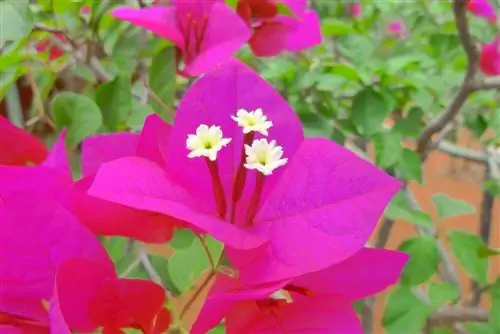
The bougainvillea can only form a flower if it receives sufficient energy from the nutrients present in the soil and through photosynthesis. Photosynthesis occurs via the leaves, which absorb sunlight and use it to produce valuable chemical energy needed for growth and flowering. The winter is quite long in Central Europe, and the triple flower usually sheds its leaves in the dark winter quarters and therefore has to form new ones in the spring.
Wake bougainvillea early from hibernation
This new growth takes both energy and time, which is why the plant usually only blooms in late summer - if at all. For this reason, you should remove the bougainvillea from its winter quarters as early as possible, keep it warmer and provide a stimulating sun simulation with plant light. In this way, the flower will sprout again quickly and can prepare for flowering even more quickly.
Tip:
The triplet flower should overwinter brightly and coolly at around five to ten degrees Celsius - this is how it best survives the low-light period. Do not water or fertilize the plant during this time!
Choosing the right outdoor location
After the last night frosts, i.e. from mid to late May, the bougainvillea belongs in a full sun, warm and protected location - a south-facing, light-colored house wall is ideal. This captures the UV light, absorbs it and releases the residual heat to the outside even at night. However, also make sure that the place you choose is airy - not drafty! - is, because standing heat only leads to an increased susceptibility to leaf sap-sucking pests such as spider mites, which weaken the plant. Therefore, place the plant pot only about ten centimeters away from the house wall so that the air can circulate.
Bougainvilleas are not houseplants
The bougainvillea, on the other hand, has no place in the apartment during the summer months. Even on very bright windows it is simply too dark for flowers to form. It needs direct, unfiltered light - then it will produce the colorful splendor you're hoping for.
Tip:
If the summer is cold and rainy, no flowers will develop despite all your efforts. Bougainvillea love sun and warmth, which is why cold and constant rain are counterproductive for lush flowering. However, since you have no influence on the climate, you can try it in a winter garden (if you have one): Install special plant lamps that replace sunlight and care for the triplet flower carefully. With a little luck you might be able to enjoy some flowers.
Water bougainvillea properly
Many people mean well and literally water their plants to death for fear of them drying out. Bougainvillea, which is very sensitive to moisture, is also affected. Although the root ball should not dry out completely, especially in specimens grown in pots (if it is too dry, the plant will also shed its leaves, which in turn prevents flower formation), but watering too frequently quickly leads to waterlogging - and this leads to rotting of the roots and the Death of the entire plant.
Water bougainvillea sparingly

Water your bougainvillea sparingly and only when the substrate has dried on the surface. Excess irrigation water should be able to drain out of the pot. After watering, pour it out of the planter or saucer so that the triple flower doesn't get its feet wet. During wintering, watering is extremely sparing: If the plant no longer has any leaves, you can even stop watering completely.
Tip:
Waterlogging can be prevented with good drainage: Choose a planter with drainage holes in the bottom of the pot. At the bottom of the pot is a layer several centimeters thick of expanded clay, pottery shards or small pebbles. Only fill in the planting substrate above this, after ideally placing a piece of water-permeable fleece between the drainage layer and the substrate.
Sufficient nutrient supply for lush flowering
Bougainvillea, even in the best location, cannot derive the necessary strength and energy for its magnificent flowering from photosynthesis alone. The heavy feeder must be regularly supplied with good fertilizer during the growing season, because a lack of nutrients also leads to a lack of flowering. Therefore, from the beginning of the leaf shoots, provide the drilling flower with a liquid flowering plant fertilizer every week to every 14 days.
Avoid over-fertilization with nitrogen
Be sure to follow the manufacturer's dosage instructions to avoid over-fertilization - this, like inadequate supply, can lead to a lack of flowering. If you do not use flowering plant fertilizer, choose a fertilizer that is low in nitrogen. Nitrogen promotes shoot and leaf growth and thus prevents flower formation as the plant puts its energy into growing. Instead, the product should primarily contain phosphorus.
Tip:
If the leaves of the bougainvillea turn yellow, there is usually an iron deficiency caused by waterlogging. At this stage, the roots are already beginning to rot and can no longer absorb sufficient nutrients. Remove the discolored foliage and cut the plant back. Repot them into a new container and into fresh substrate after also cutting off any mushy roots.
No flowering due to incorrect pruning
As a summer bloomer, bougainvillea only produces its flowers on the young shoots. Regular pruning is therefore essential, preferably in early spring. Take this measure before the leaves emerge and as early as possible. If you cut too late, photosynthesis will be hindered and the flower may fail. The plant should be cut back to about half its size in order to stimulate the formation of numerous new young shoots that will later bear flowers.
Remove dried inflorescences
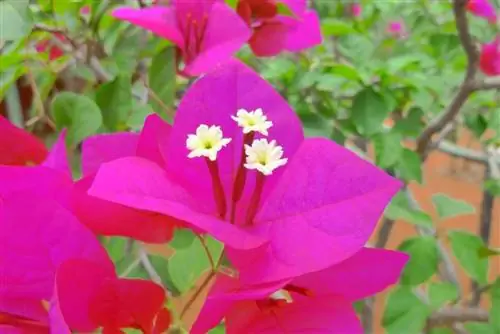
After flowering, you can safely remove the dried inflorescences, as this will encourage the plant to bloom again - after all, removing them will prevent it from producing fruits with seeds and will therefore strive to bloom again. With appropriate care and suitable weather conditions, a bougainvillea can bloom up to four times a year.
Tip:
Don't be afraid to prune. Bougainvilleas are very tolerant of pruning and sprout quickly. You can also train the climbing plants to form a standard tree or a shrub. The plants can even be easily cultivated as bonsai.
Conclusion
The exotic bougainvillea, also known as the triplet flower because of its characteristic flowers, delights the viewer with its extremely lush and colorful flowers. Here the flowers - although they are actually just colored bracts - are so close to the shoots that the foliage is basically no longer visible. However, there are many reasons for the lack of flowers. For example, the bougainvillea is very sensitive to a location that is too dark; it needs full sun and a lot of warmth. But incorrect care can also prevent flowering.

